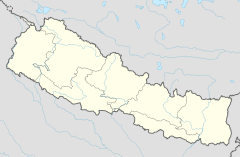| Hotel Shanker, Kathmandu | |
|---|---|
| Official Logo of Hotel Shanker, Kathmandu | |
 | |
| General information | |
| Location | Kathmandu, Nepal |
| Coordinates | 27°43′08.1″N85°19′10.1″E / 27.718917°N 85.319472°E |
| Opening | 1964 |
| Management | Hotel Shanker Pvt. Ltd. |
| Technical details | |
| Floor count | 4 |
| Design and construction | |
| Architect(s) | Kumar Narsingh Rana (Nepal's first Civil Engineer) |
| Developer | Ram Shanker Shrestha |
| Other information | |
| Number of rooms | 94 |
| Number of suites | 12 |
| Number of restaurants | 2 |
| Parking | Outdoor, more than 200 Cars |
| Website | |
| shankerhotel | |
Hotel Shanker in Kathmandu is a historic luxury heritage hotel opened in 1964 in a building dating to 1894. It is located in Lazimpat, next to the historic Narayanhity Palace Museum. The architectural style of the building is neoclassical. This palace was [1] [2] made for General Jit Shumsher Rana, (Southern Commanding General of the Army). The hotel is characterised by objets d'art. For example, the carved windows displayed in the lobby bar are over 200 years old.
Contents
Online booking at the official site was started for tourists since 2004. [3] The hotel won the Trip Advisor Travelers' choice awards for the years 2013 and 2014 in the top hotels category. [4]



